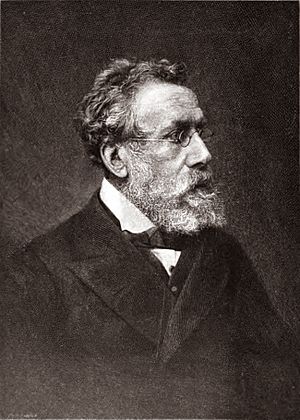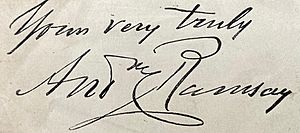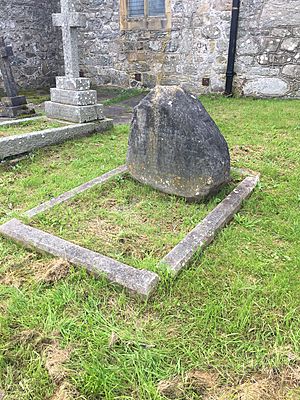Andrew Ramsay (geologist) facts for kids
Quick facts for kids
Andrew Ramsay (geologist)
|
|
|---|---|
 |
|
| Born | 31 January 1814 |
| Died | 9 December 1891 (aged 77) Beaumaris, Wales
|
| Awards | Wollaston Medal (1871) Royal Medal (1879) |
Sir Andrew Crombie Ramsay (born January 31, 1814 – died December 9, 1891) was an important Scottish geologist. He spent 40 years working for the British Geological Survey, studying rocks and landforms across Great Britain. He was known for his ideas about how glaciers shaped lakes and how the land was worn away over time.
Contents
Who Was Andrew Ramsay?
Andrew Ramsay was born in Glasgow, Scotland. For a while, he worked in business. But during his holidays, he loved exploring the Isle of Arran. This island's amazing rocks sparked his interest in geology, which is the study of Earth's physical structure and substances.
How Did He Become a Geologist?
Ramsay was so interested in Arran's geology that he built a detailed model of the island. This model was shown at a big science meeting in Glasgow in 1840. A famous geologist named Roderick Murchison noticed his work. Because of this, Ramsay got a job with the British Geological Survey in 1841. He worked there for 40 years, until 1881.
His Early Work in Wales
Ramsay's first job with the Survey was in Tenby, Wales. This meant much of his early work focused on the geology of Wales. In 1841, he published his first book, The Geology of the Isle of Arran.
In 1846, he wrote an important essay about how the land in South Wales and nearby areas of England had been worn away. He believed the sea played a big role in shaping these flat areas. However, he later realized that other natural forces, like wind and rain, were also very important in carving out the landscape.
Leading the Way in Geology
Ramsay became a professor of geology at University College, London in 1848. He also taught at the Royal School of Mines starting in 1851. In 1862, he was chosen to lead the Geological Society of London as its president.
In 1872, he took over as the Director-General of the Geological Survey, following Roderick Murchison. This was a very important position! In 1880, he was the president of the British Association meeting in Swansea. The next year, he retired and was given the special honor of being made a knight.
Studying Glaciers and Lakes
Andrew Ramsay was very interested in how ice shaped the land. In 1860, he wrote a book called The Old Glaciers of Switzerland and North Wales. He also studied how lakes were formed. He had a bold idea that some lake basins were actually dug out by huge sheets of ice called glaciers. While this idea wasn't fully accepted by everyone, it made other scientists think and helped geology move forward.
He also explored other topics, like the origin of the "Red Rocks of England" and how the rivers in England and Wales got their courses.
Teaching and Legacy
Ramsay was excellent at explaining geology. His lectures to working people in 1863 became the basis for his popular book, Physical Geology and Geography of Great Britain. This book helped many people understand the geology of their own country.
He received many awards for his work, including the Royal Medal in 1880 and the Wollaston Medal in 1871. He passed away in Beaumaris, Wales. His grave in Llansadwrn is marked by a unique glacial erratic boulder, which is a large rock moved by a glacier far from its original location. It's a fitting marker for a geologist who studied glaciers!
See also



